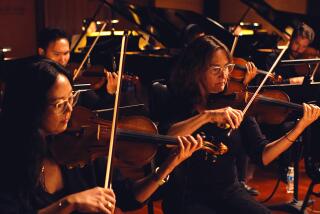Long before the construction of the Music...
- Share via
Long before the construction of the Music Center or the Library Tower, one of the city’s most striking architectural landmarks was the huge red wooden piano atop the entrance to Manning’s Piano Co. at Venice Boulevard and Oxford Avenue.
In the early 1930s, when the piano was built, the city was already dotted with oversized icons of roadside architecture: humongous hot dogs, tamales, doughnuts, ice cream cones, pickles and chili bowls.
But just south of present-day Koreatown was a monument to the city’s artistic aspirations. Jutting from a two-story, wood-frame building, a 25-foot replica of a Manning grand piano towered majestically over the street--delighting and sometimes bewildering passersby.
In the midst of the Great Depression, the piano was a strange enough landmark to warrant a mention in Ripley’s “Believe It or Not,” which described it as an object of wonderment. The New Yorker magazine had a different view and published a cartoon that used the oversized piano as evidence of Southern California’s special brand of madness.
*
Former chiropractor Ashley (Doc) Manning’s piano and organ store began as a one-man operation at 12th Street and Maple Avenue in 1910. Fifteen years later, after his company began to grow, Manning moved his business to Venice and Oxford, three miles away from the city’s commercial center downtown.
Through price discounting, saturation radio advertising, bathing beauties and imaginative architecture, Manning expanded his sales of an expensive, nonessential product, becoming the largest piano and organ dealership on the West Coast.
Manning triumphed over his out-of-the-way location and was able to draw both customers and sightseeing buses. He propped open the funky piano’s sounding board, which was painted with the company’s advertising slogan: “3 Miles from High Prices.”
In 1966, Manning sold his business to another music company, which continued to operate it under his name for four years. Then the building--actually, several buildings remodeled into one--was sold to the Refrigeration Equipment Co. The 150-foot showroom displayed scales and freezer cases instead of pianos on its three-tiered terraced floor, but the piano entrance remained intact.
In 1972, a fire consumed some adjoining buildings and the city ruled that the piano could not be left standing.
Before the refrigerator company rebuilt, the owner offered the red monument gratis. No one seemed to want it, however, and finally in 1973 pop-architecture buff and artist Tom Sewell agreed to take it.
But the noise it made when it reached its new home behind the Venice Flea Market was not musical. As a crane lifted the piano to its new foundation, slipped loose, breaking into tiny pieces.
Only two legs and the piano pedals, which had formed the doorway leading into Manning’s store, survived the crash. They now serve as the back door to Sewell’s Venice studio.
Today, refrigerators continue to be sold from the site of Manning’s original store on Venice Boulevard.
More to Read
The biggest entertainment stories
Get our big stories about Hollywood, film, television, music, arts, culture and more right in your inbox as soon as they publish.
You may occasionally receive promotional content from the Los Angeles Times.










